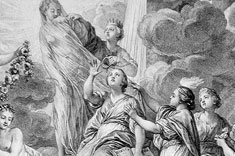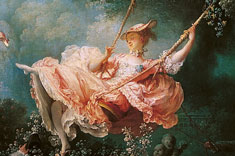
The Age of Enlightenment
The Age of Enlightenment is a period in European intellectual history that can be placed around the 1700s. The period was characterised by a strong belief in the future and the progress of reason.

The Swedish naturalist and physician Carl von Linné (1707-1778) classified and systematised plants and animals - a system that has since been further developed, but its ‘skeleton’ is still in use today. This illustration shows an overview of the animal kingdom and was included in the book Systema Naturae (1735).
The 1700s are often seen as a transition period between the 1600s and 1800s when it comes to progress within the field of science. However, in the 1700s, Newton’s science was further developed, knowledge was systematised and the chemical and industrial revolutions were born. During the Enlightenment, it was fashionable to be critical, to not take superstition at face value, to be rational, practical and to dare to express one’s opinions - qualities that one would associate the world of science in our time.
The light of Science
Joseph Wright of Derby (1734-1797), in addition to being a portrait and landscape painter, was preoccupied with contemporary scientific discoveries and experiments. In the background of the painting An Experiment on a Bird in the Air Pump from 1768 a full moon is seen. Wright was a member of the Lunar Society, which met monthly on the Monday closest to the full moon to carry out experiments. The painting depicts the set-up of an experiment in which the effect of an air pump on a white cockatoo, enclosed in a bottle, is demonstrated.
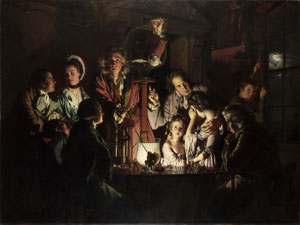
Wright specialised in the effects of light, and is especially noted for his use of chiaroscuro – a strong contrast between light and shade, creating a dramatic effect.
In the 1700s, scientific experiments were often social activities, carried out for the sake of both education and entertainment. Natural philosophers exhibited experiments in the cities they traveled through - it is likely that the man controlling the air pump was one of these travelers.
A strong emphasis is placed on how the different figures receive the presentation. The girls are more sensitive and concerned about the bird’s well-being, while an elderly man comforts them and at the same time explains the experiment to them. The boy behind them, on the other hand, is looking up at the bird with curiosity. An elderly man is staring thoughtfully at the object in the glass, which could be human lungs. Others follow the experiment closely, unlike the couple, who are looking at each other - perhaps to share amazement over the wonders of science. The natural philosopher, who is looking directly at the viewer, has long unruly hair and his face is illuminated from below, so he looks a bit ominous - he holds his hand on the air pump’s control mechanism and can give the bird either more or less air. It was from this period that we began to see men of science as having the potential for being dangerous because they were playing with the natural order of things.
The Enlightenment’s Universe
Wright’s A Philosopher Lecturing on the Orrery from around 1766 shows a mechanical model of the solar system.
An oil lamp illuminates the scene from the centre of the planetarium and may symbolise the sun. That it is dark around the experiment could be a reference to all that has not yet been discovered. Isaac Newton’s ideas were fundamental to 18th century astronomy - the heliocentric theory was widely accepted and the understanding of gravity could explain planetary motion.
In the Age of Enlightenment, François-Marie d'Arouet, also known as Voltaire (1694-1778), who promoted Newton’s research, used light as a metaphor for reason. In An Experiment on a Bird in the Air Pump and A Philosopher Lecturing on the Orrery, Wright uses light in a similar way, as a metaphor for the knowledge communicated in the lectures.
Women and Science in the Age of Enlightenment
During the Age of Enlightenment there arose an increasing interest in science among women of the upper-class. Visitors flocked to lectures on topics in science and women were not an insignificant part of the audience.
"A woman's thoughts, beyond the range of her immediate duties, should be directed to the study of men, or the acquirement of that agreeable learning whose sole end is the formation of taste; for the works of genius are beyond her reach, and she has neither the accuracy nor the attention for success in the exact sciences; as for the physical sciences, to decide the relations between living creatures and the laws of nature is the task of that sex which is more active and enterprising, which sees more things, that sex which is possessed of greater strength and is more accustomed to the exercise of that strength.
from Jean- Jacques Rousseau’s (1712-78) treatise on education Émile, or On Education from 1762.
Women who were enthusiastic about science, however, were often ridiculed and criticised for deserting their domestic duties.
In the 1700s, women did not have access to universities or scientific societies - as a result, very few had access to scientific instruments and thus could not conduct independent research.
However, physician and philosopher John Locke (1632-1704), an excellent disseminator of science, believed that observations and experiments were essential to pass on knowledge and that women should receive a better education.
Mother and Astronomer

Margaret Bryan with her daughters by William Nutter, engraving by Samuel Shelley. Image source: The National Portrait Gallery, London.
In this portrait, Margaret Bryan and her daughters are surrounded by measuring instruments and scientific models. Here, Margaret Bryan is assigned both the role as mother and natural philosopher, which suggest that the two roles are not incompatible.
When Bryan is shown in the company of her daughters and scientific instruments, the image goes against the images of women that were dominant in the 1700s. The daughters illustrate perhaps more than Margaret Bryan’s role as a mother - they could represent the future generations of women who will receive eduation. Bryan taught girls at an elite school in London and wrote books on astronomy and other scientific topics.
The Chemical Revolution
At the start of the 1700s, work was still based on Aristotle’s theory that the elements were fire, earth, water and air. A number of prominent natural philosophers came into the field and contributed new findings and laid the foundation for the understanding of the elements we have today.
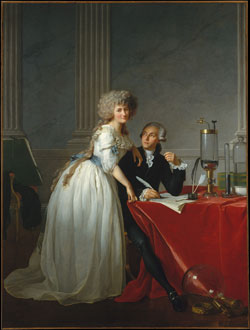
Marie-Anne Pierrette Paulze or Madame Lavoisier was an artist and studied with David, the painter of this double portrait. Seen behind Paulze is a portfolio, which refers to Paulze’s work as an artist, while to the right of Lavoisier is some of the specially constructed equipment Lavoisier used for his chemical experiments. At the same time as the painting portrays Lavoisier and Paulze, it can also be seen as a picture of the union between art and science.
The most prominent among these must be Antoine-Laurent Lavoisier (1743-1794), often referred to as the father of the chemical revolution. Lavoisier showed that water is a chemical compound of oxygen and hydrogen and contributed several concepts that have been important to the development of chemistry - many of them still in use to this day. Lavoisier was behind the publication of books and the journal Annales de chimie, where the new chemistry was presented.
In Portrait of Antoine-Laurent Lavoisier and his wife from 1788 by Jacques-Louis David (1748- 1825), Lavoisier looks lovingly at his wife, born Marie-Anne Pierrette Paulze (1758-1836).
Paulze (1758-1836) married Lavoisier when she was 13 and he was 28 years old. Before the marriage, they had often talked about topics in geology, astronomy and chemistry.
Paulze was present when her husband performed experiments, she illustrated his books, translated scientific writings from English and hosted many parties where eminent men of science discussed ideas in science. Seen here is one of Paulze’s illustrations included in Lavoiser’s textbook Traité Élémentaire de Chimie, published in 1789.
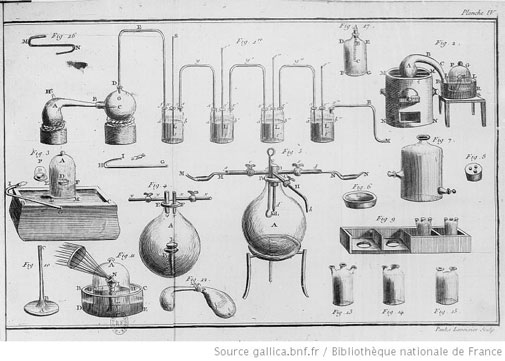 Lavoisier managed to make enemies with many, both inside and outside the field of science. Lavoisier’s discovery that water was made up of hydrogen and oxygen was, for example, based on an experiment first carried out by the English physicist Cavendish. Cavendish’s assistant had told Lavoisier about the experiment during a visit to Paris, after which Lavoisier recreated it; this led Lavoisier to his groundbreaking discovery, but when Lavoisier presented his results at the Académie Royal des Sciences he failed to mention the inspiration from Cavendish.
Lavoisier managed to make enemies with many, both inside and outside the field of science. Lavoisier’s discovery that water was made up of hydrogen and oxygen was, for example, based on an experiment first carried out by the English physicist Cavendish. Cavendish’s assistant had told Lavoisier about the experiment during a visit to Paris, after which Lavoisier recreated it; this led Lavoisier to his groundbreaking discovery, but when Lavoisier presented his results at the Académie Royal des Sciences he failed to mention the inspiration from Cavendish.
In addition, as a former tax collector, Lavoisier was not popular among the revolutionaries. During the Reign of Terror in the French Revolution, Lavoisier was executed by guillotine – Paulze fought in vain to save him, and made sure that his memoirs about his work in chemistry wew afterwards published.
Heritage of the Enlightenment
The Prussian philosopher Immanuel Kant (1724-1804) wrote in 1784 that the Age of Enlightenment (aufklärung) was not over – it was a process in which the dark corners of the human mind should be revealed through study and independent thinking, which would lead to “man’s emergence from his self-imposed nonage.”
The Enlightenment’s most significant contribution to science is perhaps the mentality that is fundamental to the scientific work process and progress: the importance of knowledge and education and that curiosity and critical questioning are weighted positively. Therefore there are many who think that the Enlightenment is both a historical period and an approach to the world which is dominant in much of the world this day.
| << Previous | Next >> |


